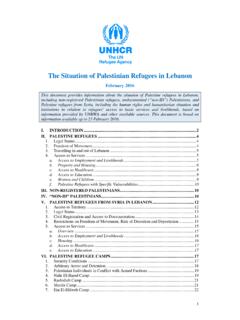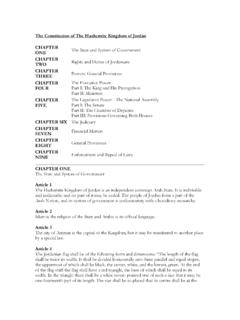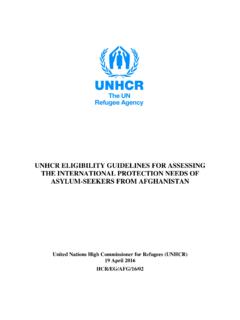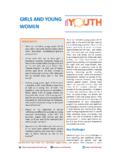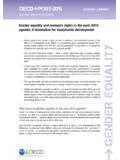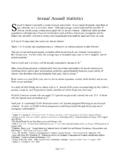Transcription of Safe Schools and Learning Environment - Refworld
1 safe Schools and Learning Environment How to Prevent and Respond to violence in Refugee Schools A Guide Technical Support Section Division of Operational Services UNHCR Geneva June 2007 Technical Support Section The Education Unit, which is part of the Technical Support Section (TSS) of UNHCR, guides and assists the field in matters related to education. The unit develops guidelines and tools, provides training, mobilizes resources and strengthens global partnerships. The ultimate aim of all these activities is to bolster the protection of children of concern to UNHCR by safeguarding their right to safe and high-quality education.
2 Indeed, the Education Unit has defined access to safe Learning environments as a priority in its strategy for 2007-2009. The goal is to increase school enrolment and attendance rates by 10%/year. To achieve this aim, it is critical that education is available through all phases of UNHCR operations and partners are mobilized to provide post-primary schooling to adolescents. Acknowledgments These guidelines could not have been developed without the participation of UNHCR field offices and other units and departments at headquarters. In addition, the International Rescue Committee (IRC) and the Gender Task team of the Inter-agency Network for Education in Emergencies, Chronic Crises and Early Reconstruction provided valuable inputs and comments.
3 Technical Support Section (TSS) UNHCR Geneva 2/43 The UN Refugee Agency L'Agence des Nations Unies pour les r fugi s Table of Contents Introduction and Overview ..4 1- What is safe education?..4 2- Why the need of safe education?..5 3- The purpose and structure of the 4- Guiding principles: Responding to violence in educational settings ..7 Step1. Situational Analysis: Understanding violence in educational settings and assessing the quality of support services..9 1- Types of violence in Learning environments ..9 2- Identifying the root causes of Step 2. Preventive Measures: Creating safe and supportive Learning 1- Advocating for national policies ..14 2- Establishing safe and supportive Learning environments.
4 15 3- Strengthening the supervision of education staff and reinforcing their capacities in camp settings ..17 4- Teaching and Learning : promoting a culture of peace and dialogue ..21 5- Empowering students ..22 6- Empowering the community/parents to keep children safe ..23 Step 3. Response Mechanisms: Ensuring children have access to support Step 4. Monitoring and evaluation: Ensuring safe education..27 Key Reference Materials ..30 Annex 1: Codes of Conduct for Refugee Schools ..32 Annex 2: Applying Standard Operating Procedures on Sexual and Gender-Based violence in school Settings ..34 Annex 3: Quick Guidance 1-Key Steps and Actions to Remember (for multi-functional teams).
5 36 2-Suggested activities and indicators (for programme officers) ..38 3-Ten standards for a rights-based and child-friendly 3/43 The UN Refugee Agency L'Agence des Nations Unies pour les r fugi s Introduction and Overview 1- What is safe education? school is not always a safe place for a refugee child; quite often, it is at school that he or she is abused or exploited. The nature of violence inflicted on children in Learning environments can be emotional, physical and psychological, and range from the subtle to the very explicit. All too frequently it is sexual and Without adequate monitoring, reporting and referral mechanisms, children in Schools often face severe corporal punishment, peer-to-peer violence and sexual harassment or exploitation.
6 The perpetrators could include teachers, other authority figures and the staff of international organizations and non-government organizations. The risk of exploitation and abuse is higher at the upper-primary and secondary levels, when children reach adolescence. Girls are especially vulnerable at this stage, and may be forced to engage in so-called survival sex2 to cover school costs and stay on good terms with their teachers. Schools and teachers are highly influential in a child s life, and have a lasting impact on attitudes and behaviour. As such, unsafe Learning environments contribute to the perpetuation of violence within communities.
7 To be effective, a strategy for the protection of children must guarantee that their Learning environments are safe and secure. Within its protection mandate, UNHCR plays a key role in keeping Learning environments free of violence . 1 Sexual and gender-based violence is directed against a person on the basis of gender or sex. It includes acts that inflict physical, mental or sexual harm or suffering, and is largely rooted in unequal power relations. 4/43 The UN Refugee Agency L'Agence des Nations Unies pour les r fugi s 2 Although the definition of sex survival is still under discussion, it is understood to refer to a situation whereby a person of concern to UNHCR engages in sex in order to obtain money or material assistance, including for education, to meet her/his basic needs and/or those of other family members.
8 2- Why the need of safe education? To save lives and ensure the effective protection of girls and boys of concern to UNHCR in Learning environments. To ensure that Learning environments provide quality education. To empower girls by ending gender discrimination in school environments. To increase school attendance, especially at the secondary level. To help the search for durable solutions by promoting a culture of peace and dialogue. To provide children with the skills to achieve self-reliance. To prevent all forms of sexual and gender-based violence , guard children against sexually transmitted diseases - including HIV and AIDS - and reduce teenage pregnancies and their associated risks.
9 3- The purpose and structure of the guidelines There is mounting evidence that students of concern to UNHCR are exposed to sexual harassment and exploitation in school settings. Participatory assessments reveal that children are abused - sometimes by their own teachers - in many areas where UNHCR operates, . The purpose of these guidelines is to support UNHCR staff, non-governmental organizations (NGOs) and other partners in education take practical steps to prevent and respond to violence in Schools . By recognizing the existence of violence in refugee Schools and exploring its root causes, UNHCR hopes to draw attention to the urgent need to ensure safe education is available to all children of concern.
10 The guidelines are organized in four main steps , or chapters, which provide UNHCR staff and other partners with a framework for developing effective prevention and response strategies. These steps are the following: 5/43 The UN Refugee Agency L'Agence des Nations Unies pour les r fugi s (1) Situational Analysis, to identify the causes of violence in Schools and assess existing support services, resources and capacities. (2) Preventive Measures, to create a safe and supportive Learning Environment . (3) Response Mechanisms, to provide victims/survivors with the appropriate services. (4) Monitoring and Evaluation, to ensure that measures to provide a safe education are effective.




